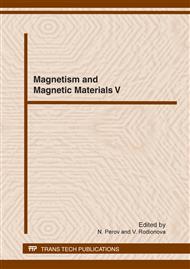p.425
p.429
p.435
p.439
p.443
p.447
p.451
p.455
p.459
Ferromagnetic-Like Behavior of Pt Nanoparticles
Abstract:
The magnetic properties of small 4d, 5d metal nanoparticles of Pd, Pt (clusters) are attracting a great attention because these materials in bulk are paramagnetic. In this work we report the ferromagnetic-like behavior of the small Pt nanoparticles prepared by chemical method. Highly dispersed Pt clusters have been synthesized on the surfaces of a porous spherical γ-Al2O3 particles. The process of the chemical deposition of metalorganic fluid with employment of the supercritical fluid was used. The samples of the Pt/γ-Al2O3 nanoparticles have been prepared in INEOS RAS. The nanoparticles size distribution was determined by small-angle X-rays scattering (SAXS). It was found that the Pt clusters have a bimodal particle size distribution with two peaks: R1max=20 Å and R2max=40 Å. The magnetic properties of the clusters have been investigated, using VSM magnetometer, in magnetic field up to ±3 kOe and at a temperature range from 80 to 400 K. It was observed that Pt/γ-Al2O3 nanoparticles show the ferromagnetic-like behavior in whole specified temperature range, the value of coercivity decreases gradually from 130 Oe to 80 Oe. The origin of ferromagnetic-like behavior of the Pt/γ-Al2O3 nanoparticles is discussed.
Info:
Periodical:
Pages:
443-446
Citation:
Online since:
June 2012
Price:
Сopyright:
© 2012 Trans Tech Publications Ltd. All Rights Reserved
Share:
Citation:


